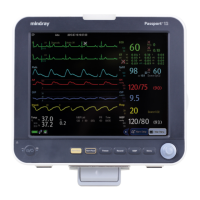Passport 12/Passport 8 Operator’s Manual 8-23
8.10 Troubleshooting
This section lists the problems that might occur. If you encounter the problems when using the equipment or
accessories, check the table below before requesting for services. If the problem persists, contact your service personnel.
CAUTION
Never try to disassemble the equipment or supplied accessories. There are no internal user-serviceable
parts.
Symptoms Possible Cause Correction Action
Noisy ECG traces
Loose or dry electrodes Apply fresh and moist electrodes.
Defective electrode wires Replace wires if necessary.
Patient cable or leads are routed too
close to other electrical devices
Move the patient cable or leads away from the
electrical device.
Excessive Electro-surgical
Interference
Wrong ECG cable used Use ESU-proof ECG cables. For details, refer to
section 27.1 ECG Accessories.
Muscle Noise
Inadequate skin preparation prior to
application of electrode, tremors,
tense subject, and/or poor electrode
placement
Repeat skin preparation as described in section
8.3.1 Preparing the Patient and Placing the
Electrodes and re-place the electrodes.
Apply fresh, moist electrodes.
Avoid muscular areas.
Intermittent Signal Connections not tight and/or properly
secured
Check that the cables are properly connected.
Electrodes dry or loose Repeat skin preparation as described in section
8.3.1 Preparing the Patient and Placing the
Electrodes and apply fresh and moist electrodes.
Cable or lead wires damaged Change cable and lead wires.
Excessive alarms: heart rate,
lead fault
Electrodes dry Repeat skin preparation as described in section
8.3.1 Preparing the Patient and Placing the
Electrodes and apply fresh, moist electrodes.
Excessive patient movement or
muscle tremor
Reposition the electrodes.
Replace fresh and moist electrodes if necessary.
Low Amplitude ECG Signal Gain set too low Set the gain as required. For details, refer to section
8.5.4 Changing ECG Wave Settings.
Electrodes dry / old Apply fresh and moist electrodes.
Skin improperly prepared Repeat skin preparation as described in section
8.3.1 Preparing the Patient and Placing the
Electrodes.
This could be the patient’s normal QRS
complex
Verify with another well-functioning monitor.
Electrode could be positioned over a
bone or muscle mass
Move ECG patches away from the bone or muscle
mass.

